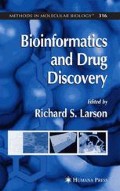Abstract
In the last 10 yr, efforts have begun to combine the goals and approaches of computational molecular design and protein sequence analysis to provide tools for the rational mutagenesis and functional modification of proteins. These approaches use analysis of the three-dimensional structure of a protein to guide the selection of appropriate amino acid sequences to create desired properties or functions. The convergence of low-cost, high-speed computers, a tremendous increase in protein structure information, and a growing understanding of the forces that control protein structure has resulted in dramatic advances in the ability to control protein function and structure and to create the first truly artificial proteins. Various academic software packages have been developed for in silico protein design. The methods for selecting the protein structure, defining the portion to be designed, and choosing the input parameters for the software are described in this chapter.
Access this chapter
Tax calculation will be finalised at checkout
Purchases are for personal use only
References
Pabo, C. (1983) Molecular technology: designing proteins and peptides. Nature 301, 200.
Dahiyat, B. I. and Mayo, S. L. (1996) Protein design automation. Protein Sci. 5, 895–903.
Desjarlais, J. R. and Handel, T. M. (1995) De novo design of the hydrophobic cores of proteins. Protein Sci. 4, 2006–2018.
Hellinga, H. W. and Richards, F. M. (1994) Optimal sequence selection in proteins of known structure by simulated evolution. Proc. Natl. Acad. Sci. USA 91, 5803–5807.
Kuhlman, B., Dantas, G., Ireton, G. C., Varani, G., Stoddard, B. L., and Baker, D. (2003) Design of a novel globular protein fold with atomic-level accuracy. Science 302, 1364–1368.
Marvin, J. S., Corcoran, E. E., Hattangadi, N. A., Zhang, J. V., Gere, S. A., and Hellinga, H. W. (1997) The rational design of allosteric interactions in a monomeric protein and its applications to the construction of biosensors. Proc. Natl. Acad. Sci. USA 94, 4366–4371.
Marvin, J. S. and Hellinga, H. W. (2001) Conversion of a maltose receptor into a zinc biosensor by computational design. Proc. Natl. Acad. Sci. USA 98, 4955–4960.
Hayes, R. J., Bentzien, J., Ary, M. L., et al. (2002) Combining computational and experimental screening for rapid optimization of protein properties. Proc. Natl. Acad. Sci. USA 99, 15,926–15,931.
Dahiyat, B. I., Gordon, D. B., and Mayo, S. L. (1997) Automated design of the surface positions of protein helices. Protein Sci. 6, 1333–1337.
Malakauskas, S. M. and Mayo, S. L. (1998) Design, structure and stability of a hyperthermophilic protein variant. Nat. Struct. Biol. 5, 470–475.
Su, A. and Mayo, S. L. (1997) Coupling backbone flexibility and amino acid sequence selection in protein design. Protein Sci. 6, 1701–1707.
Luo, P., Hayes, R. J., Chan, C., et al. (2002) Development of a cytokine analog with enhanced stability using computational ultrahigh throughput screening. Protein Sci. 11, 1218–1226.
Filikov, A. V., Hayes, R. J., Luo, P., et al. (2002) Computational stabilization of human growth hormone. Protein Sci. 11, 1452–1461.
Dahiyat, B. I. and Mayo, S. L. (1997) Probing the role of packing specificity in protein design. Proc. Natl. Acad. Sci. USA 94, 10,172–10,177.
Marshall, S. A. and Mayo, S. L. (2001) Achieving stability and conformational specificity in designed proteins via binary patterning. J. Mol. Biol. 305, 619–631.
Marshall, S. A., Morgan, C. S., and Mayo, S. L. (2002) Electrostatics significantly affect the stability of designed homeodomain variants. J. Mol. Biol. 316, 189–199.
Dahiyat, B. I. and Mayo, S. L. (1997) De novo protein design: fully automated sequence selection. Science 278, 82–87.
Hellinga, H. W. and Richards, F. M. (1991) Construction of new ligand binding sites in proteins of known structure. I. Computer-aided modeling of sites with pre-defined geometry. J. Mol. Biol. 222, 763–785.
Hellinga, H. W., Caradonna, J. P., and Richards, F. M. (1991) Construction of new ligand binding sites in proteins of known structure. II. Grafting of a buried transition metal binding site into Escherichia coli thioredoxin. J. Mol. Biol. 222, 787–803.
Dwyer, M. A., Looger, L. L., and Hellinga, H. W. (2004) Computational design of a biologically active enzyme. Science 304, 1967–1971.
Bolon, D. N. and Mayo, S. L. (2001) Enzyme-like proteins by computational design. Proc. Natl. Acad. Sci. USA 98, 14,274–14,279.
Dwyer, M. A., Looger, L. L., and Hellinga, H. W. (2003) Computational design of a Zn2+ receptor that controls bacterial gene expression. Proc. Natl. Acad. Sci. USA 100, 11,255–11,260.
Looger, L. L., Dwyer, M. A., Smith, J. J., and Hellinga, H. W. (2003) Computational design of receptor and sensor proteins with novel functions. Nature 423, 185–190.
Steed, P. M., Tansey, M. G., Zalevsky, J., et al. (2003) Inactivation of TNF signaling by rationally designed dominant-negative TNF variants. Science 301, 1895–1898.
Ponder, J. W. and Richards, F. M. (1987) Tertiary templates for proteins: use of packing criteria in the enumeration of allowed sequences for different structural classes. J. Mol. Biol. 193, 775–791.
Dunbrack, R. L. Jr. and Karplus, M. (1993) Backbone-dependent rotamer library for proteins: application to side-chain prediction. J. Mol. Biol. 230, 543–574.
Ross, S. A., Sarisky, C. A., Su, A., and Mayo, S. L. (2001) Designed protein G core variants fold to native-like structures: sequence selection by ORBIT tolerates variation in backbone specification. Protein Sci. 10, 450–454.
Kuhlman, B. and Baker, D. (2000) Native protein sequences are close to optimal for their structures. Proc. Natl. Acad. Sci. USA 97, 10,383–10,388.
Author information
Authors and Affiliations
Editor information
Editors and Affiliations
Rights and permissions
Copyright information
© 2006 Humana Press Inc.
About this protocol
Cite this protocol
Dahiyat, B.I. (2006). In Silico Protein Design. In: Larson, R.S. (eds) Bioinformatics and Drug Discovery. Methods in Molecular Biology, vol 316. Humana Press. https://doi.org/10.1385/1-59259-964-8:359
Download citation
DOI: https://doi.org/10.1385/1-59259-964-8:359
Publisher Name: Humana Press
Print ISBN: 978-1-58829-346-6
Online ISBN: 978-1-59259-964-6
eBook Packages: Springer Protocols

